If you’re looking for an enduring splash of color in your North Dakota garden, perennial flowers are your answer! Perennials, unlike their annual counterparts, bloom year after year, offering a reliable burst of life and beauty to your garden. The climate in North Dakota can be quite particular, so it’s important to choose perennials that can withstand its conditions. So, what types of perennial flowers should you plant in North Dakota?
1. White Yarrow (Achillea millefolium)
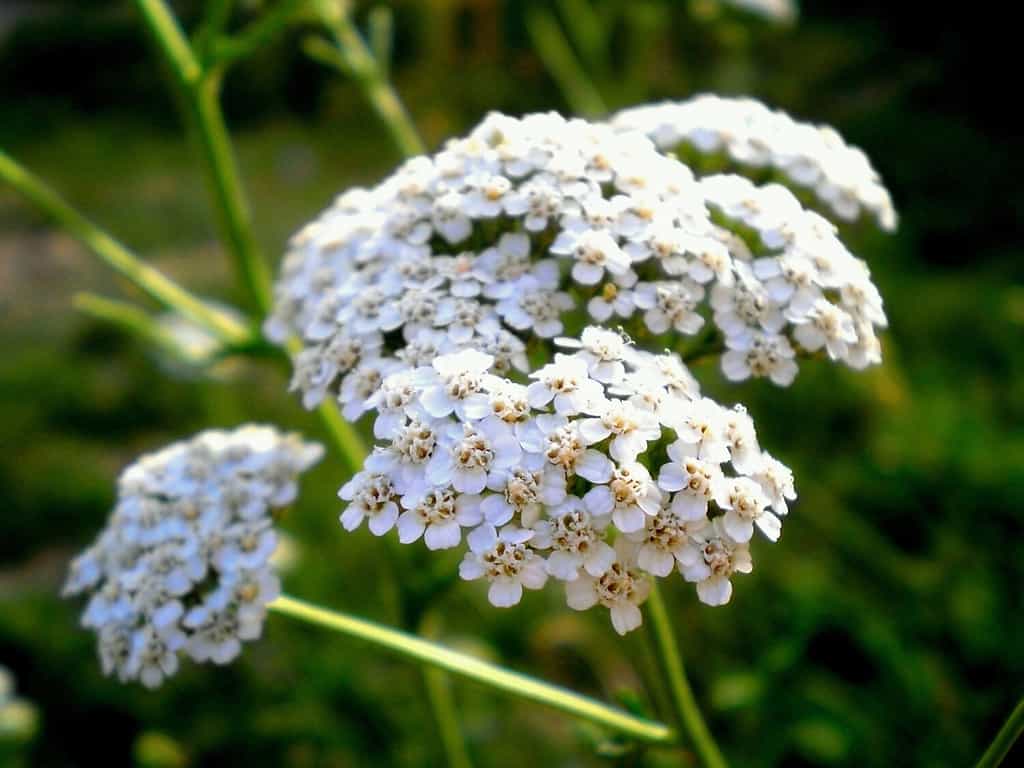
The white yarrow attracts many beneficial pollinators.
©SakSa/Shutterstock.com
First on the list of best perennial flowers for North Dakota is the white yarrow. This elegant perennial wildflower boasts bountiful clusters of large, flat-topped blooms. These blooms each span about 5 inches and are densely packed with 20-25 delicate creamy-white blossoms.
These blooms are supported by tall stems and underpinned by a base of pleasantly fragrant, fern-like, green foliage that’s resistant to disease. Both the blossoms and the foliage maintain their beauty for an extended period. This makes the white yarrow an excellent addition to any garden and an ideal choice for prairie or meadow landscapes.
As a plus, white yarrow attracts butterflies, bees, and other beneficial pollinators to the garden.
This plant flourishes in full sunlight with soil that is moderate in moisture, ranging from dry to medium. And make sure the soil drains well. On the other hand, it’s best to steer clear of overly rich, moist soils, as these could make your yarrow grow lanky or cause it to droop. Although this flower can tolerate some light shade, the white yarrow displays its best colors and blossoms under the full sun. This plant can endure a range of climates, suitable for hardiness zones 3 through 9.
Despite its many advantages, be aware that this plant can be toxic to dogs, cats, and horses. So, if you do plant it in your backyard, make sure to supervise your pets when they roam around.
2. Great Blanket Flower (Gaillardia aristata)

Great blanket flowers are native to North Dakota.
©Venchelana/Shutterstock.com
Another one of the best perennial flowers for North Dakota is the enduring western native known as Gaillardia aristata, or the great blanket flower.
This upright perennial wildflower showcases beautiful daisy-like blooms. The blooms are about 3 inches in diameter, adorned with a red center disk encircled by red rays tipped with yellow. Displaying its vivid colors from late spring to fall, these blooms offer a consistent splash of color in gardens or plant containers.
Rich in sweet nectar, these blossoms are a magnet for many pollinators, such as bees and butterflies, while birds take delight in their seed heads. Recognized as a significant wildflower of the prairies and meadows, the great blanket flower is not only heat and drought-resistant but also straightforward to cultivate and requires minimal care.
This flower shines when used in naturalistic plantings and proves equally striking as an ornamental feature or a mass display in gardens. Great blanket flowers have a long blooming period, often starting in late spring and continuing through the fall. This extended flowering season adds to their appeal as they provide color and interest in the garden for an extended period.
The great blanket flower thrives under full sunlight in average to medium well-drained soils, ranging from dry to moist. It prefers organically rich, sharply drained soils but can cope well with dry soils and periods of drought, requiring extra watering only under prolonged hot, dry conditions.
Interestingly, this perennial flower is native to North Dakota!
3. Russian Sage (Perovskia atriplicifolia)
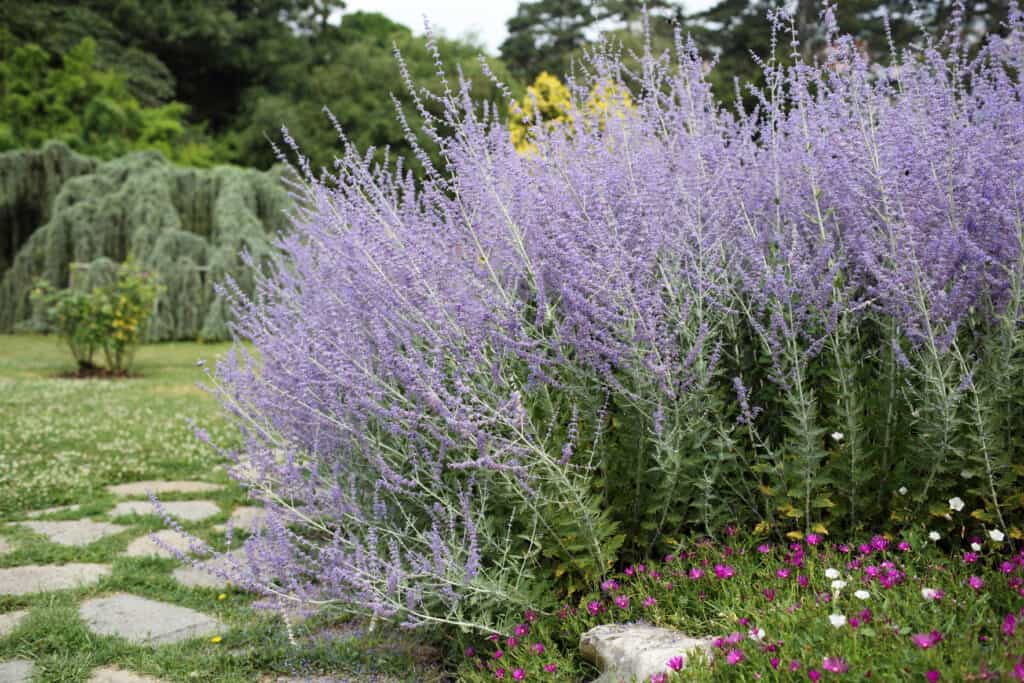
Blooming from summer to mid-fall, the Russian sage is a great perennial to plant in North Dakota.
©iStock.com/loflo69
The Russian sage boasts delicate lavender flower spikes that tower over the foliage from early summer through to mid-fall. These beautiful blossoms are ideal for bouquets or arrangements. Its appealing, fragrant, narrow leaves take on a silver hue in the spring, transitioning to a grayish-green color as the season progresses.
This herbaceous perennial displays an upright spreading growth pattern. It adds an incredibly fine and subtle texture to any garden layout, enhancing the overall aesthetics.
Russian sage is a relatively easy-to-maintain plant. It’s best to trim it back to the ground in late winter, just before the active growth phase kicks in. This plant is excellent for attracting butterflies to your garden, yet it doesn’t hold much appeal for deer, who usually bypass it in search of more enticing options. The plant also doesn’t have any notable drawbacks.
Russian sage prefers full sunlight. It favors dry to average moisture conditions with very well-drained soil, and it tends not to survive in waterlogged areas. Being drought-tolerant, it is an optimal selection for low-water gardens or xeriscaping. Xeriscaping is the idea of designing landscapes to reduce or eliminate irrigation.
While this plant is adaptable to various soil types, it shows a clear preference for alkaline soils. An added bonus is its high tolerance for urban pollution, allowing it to flourish even in city environments.
4. New England Aster (Symphyotrichum novae-angliae)

New England aster boasts beautiful daisy-like flowers.
©iStock.com/McKinneMike
Among the tallest and most striking asters in North Dakota is the New England aster. This robust, upright perennial has an abundance of eye-catching daisy-like flowers. Each blossom is about 1.5 inches wide, featuring rose-purple petals that surround bright yellow centers.
These beautiful blooms attract various pollinating insects, including miner bees, leaf-cutter bees, and bumblebees.
The New England aster is a bold presence in the garden, especially as the season turns towards fall. It is a North American native that is easy to grow, has a long lifespan, brings a delightful splash of fall color, and serves as a valuable nectar source for butterflies. During cloudy days or nighttime, the flowers tend to droop and close, but they eagerly reopen and resume their stunning display with the return of the sun, continuing to do so for weeks.
The New England aster flourishes in full sunlight with average to medium moisture, well-drained soils. It prefers moist, nutrient-rich soils. Good air circulation is also important to prevent foliage diseases like powdery mildew. This plant is hardy and can thrive in climates corresponding to zones 4 through 8.
5. Arrowleaf Balsamroot (Balsamorhiza sagittata)
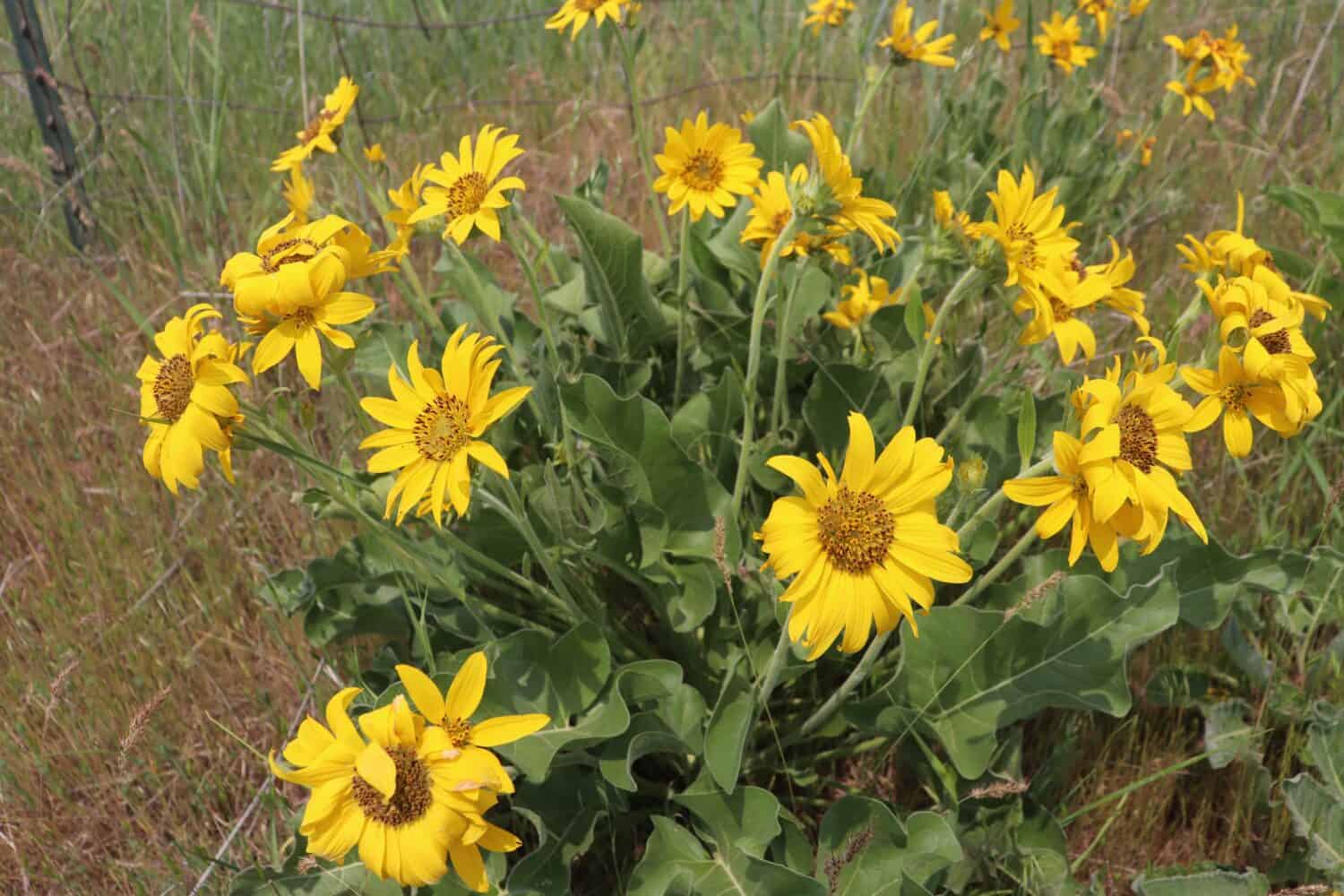
This wildflower grows in full sun.
©Sally McBeanpod/Shutterstock.com
The arrowleaf balsamroot is a perennial that lives a long life, notable for its unique basal rosette comprised of arrowhead-shaped leaves ranging in color from silvery white to green. These leaves span 2 to 18 inches in length. From late spring to mid-summer, numerous flower stems arise from the root crown, adorned with smaller, linear to elliptic leaves. These stems showcase solitary sunflower-like blossoms, each with 8-25 strap-shaped ray flowers measuring 1-2 inches long, encircling a central disk.
These charming flowers are a magnet for pollinators, while the seeds serve as food for birds and rodents. Moreover, the arrowleaf balsamroot is a grazing plant for cattle, sheep, elk, and pronghorn during the spring and summer seasons.
For the best performance, the arrowleaf balsamroot should be grown in full sunlight, in silty to loamy, acidic to neutral, dry to moist, well-drained soils. It can tolerate partial shade and is resistant to drought once established.
Interestingly, this perennial flower is a native species of North Dakota! It is adapted to the local ecosystem and can be a perfect choice for native plant gardens or restoration projects.
6. Yellow Trumpet Vine (Campsis radicans Flava)
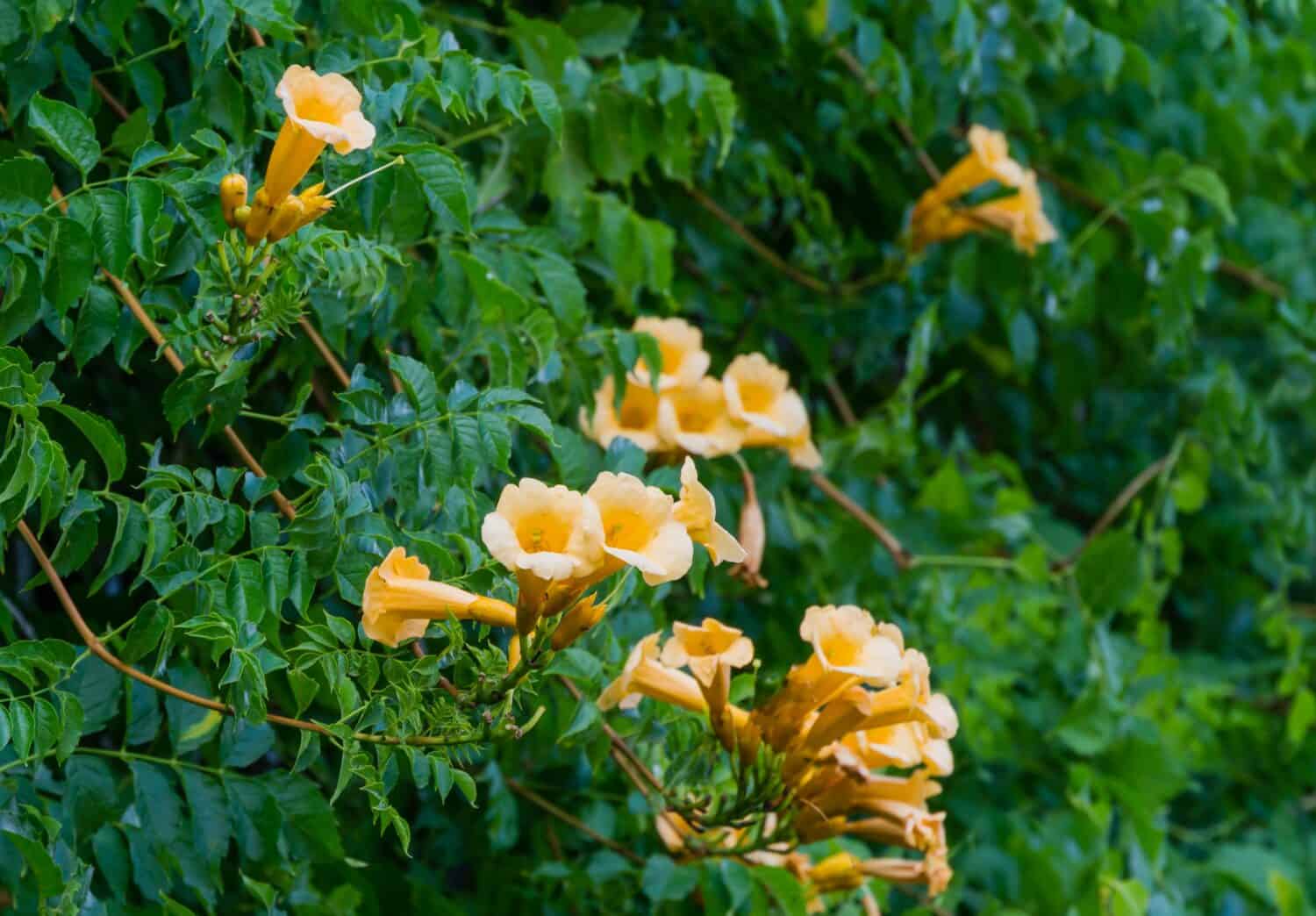
A North American native, the yellow trumpet fine boasts golden-yellow trumpet-shaped flowers.
©Marinodenisenko/Shutterstock.com
The yellow trumpet vine, a native of North America and an award-winning variety, is a woody climber. It stands out with its remarkably vibrant golden-yellow trumpet-shaped flowers, each about 3 inches long. These stunning tubular flowers bloom throughout the summer in clusters at the branch ends, offering a prolonged and breathtaking floral display.
These flowers are a favorite amongst hummingbirds, who are consistently drawn to them. After the blooms fade, appealing bean-like seed pods follow. The foliage is made up of shiny, dark green leaves on the upper side and dull green on the underside and sheds in the fall.
The yellow trumpet vine climbs and sprawls across anything in its way using aerial rootlets. Like English Ivy, these rootlets can potentially harm wood, stone, and brick surfaces. However, it’s handy for controlling erosion. Despite its aggressive growth habit, this vine is frequently cultivated for its radiant flowers and is a common sight in Mediterranean gardens. It’s crucial to keep its rapid spread in check.
This vine thrives in lean to average, moist, well-drained soils and can handle full sun or partial shade. It can adapt to a wide variety of soil types, with the best flower production seen in full sun.
7. Rocky Mountain Iris (Iris missouriensis)
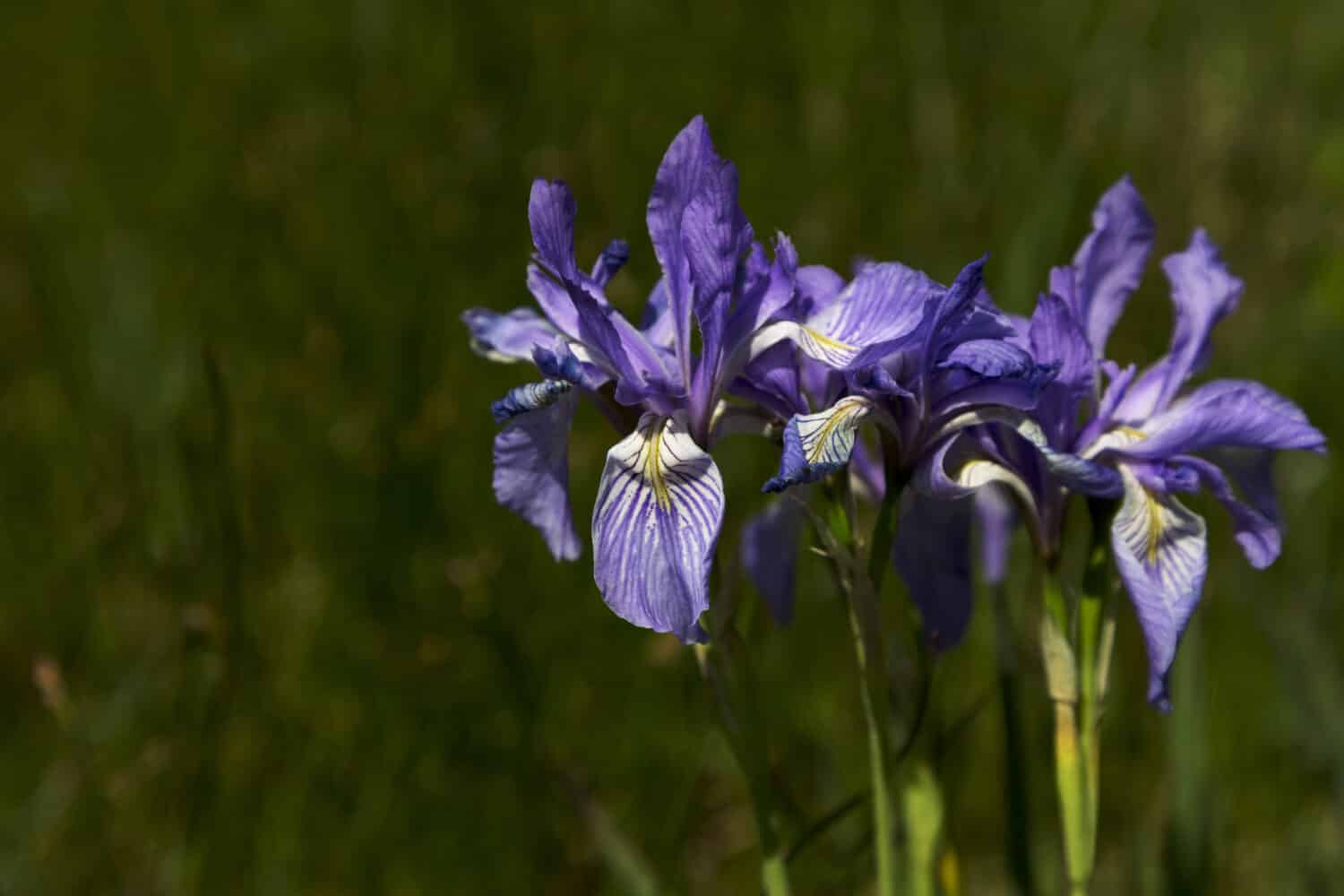
A perennial, the Rocky Mountain iris blooms from late spring to early summer.
©Florence-Joseph McGinn/Shutterstock.com
The Rocky Mountain iris, noted for its resilience, is a spreading perennial that grows from rhizomes. It has large, delicate flowers of pale blue or blue-violet hue, each spanning 2-3 inches in length. The petals, or sepals, are deeply veined in dark purple and showcase a yellow-white central pattern.
Blooming from late spring to early summer, each stem bears 1 to 4 blossoms, held on robust stalks that emerge from dense clusters of long, arching blue-green leaves.
This compact rhizomatous perennial is native to the wet meadows, dry steppes, and open woodlands of North Dakota. Once established, it can tolerate some dry soils, but only after it has flowered. The Rocky Mountain iris makes an excellent addition to sunny perennial borders or foundation plantings.
For optimal growth, the Rocky Mountain iris prefers full sun with medium to wet, fertile, slightly acidic, well-drained soils. In regions with hot summers, it appreciates some afternoon shade.
It’s important to note that all parts of this plant can cause discomfort if eaten. When handling this plant, wearing gloves and other protective equipment is advised. Also, the plant is toxic to dogs, cats, and horses.
8. Wood Lily (Lilium philadelphicum)
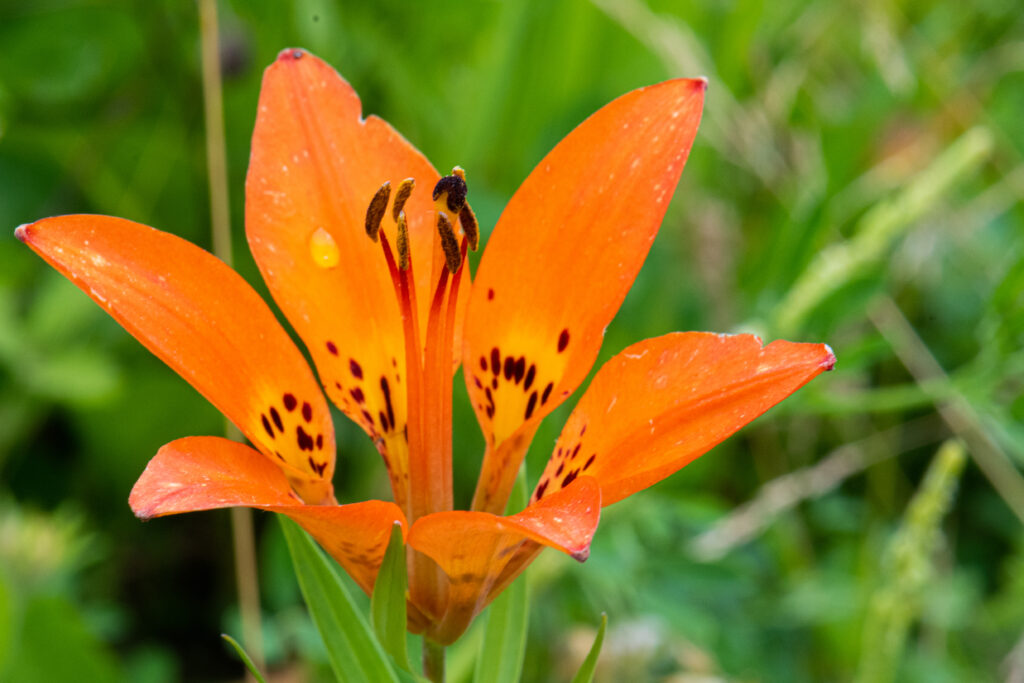
A perennial wildflower, the wood lily draws in pollinators.
©iStock.com/Derwyn
The wood lily, widely found across North America, is a perennial wildflower that flaunts red-orange flowers that can grow up to 1-3 inches wide. It blooms from the middle to the end of summer, lasting up to five weeks, with its petals charmingly speckled with dark purple-brown spots.
In contrast to many other lily species that have hanging flowers to shield their pollen, the wood lily’s flowers face upwards, aiming to draw in passing hummingbirds and butterflies to assist with pollination. Typically, each plant has between 1 to 4 flowers.
It’s a perfect addition to garden meadows and serves as a great border plant, offering a dramatic dash of color against grasses or other perennials. Due to its stunning beauty, the wood lily is often picked by visitors and tends to vanish rapidly from heavily grazed meadows.
This flower thrives in full sun or partial shade in well-drained soils that range from sandy to loamy and can handle moisture levels from dry to moist. However, for optimal flowering, full sun is recommended.
Although not harmful to dogs or any other known species, keep in mind that this flower is toxic to cats.
9. Purple Poppy Mallow (Callirhoe involucrata)

Also called wine cups, the purple poppy mallow is drought-tolerant.
©iStock.com/RukiMedia
The purple poppy mallow, often compared to wine cups, charmingly brightens the landscape from late spring to early fall with its vibrant magenta, cup-shaped flowers on low-lying stems. These striking, upward-facing blossoms, which can reach up to 2.5 inches in width, open with the morning light, close at dusk, and stay closed after they are pollinated.
These poppy-like flowers are made up of five petals, each with a white spot at the base, surrounding a noticeable cluster of stamens at the center. In milder climates, this plant retains its deeply cut, hand-shaped, green leaves all year round, adding some winter appeal to the garden. As a native prairie plant, this ground-covering perennial is attractive, spreading, and tolerant to drought.
The purple poppy mallow thrives in dry to medium, well-drained soils under full sun. Survival hinges on good drainage, and it can tolerate nutrient-poor and rocky soils. However, if conditions become too damp, the plant may be susceptible to rust.
10. Fireweed (Chamaenerion angustifolium)

Boasting pinkish-purple flowers, the fireweed can easily overrun a garden.
©Tomas Nevesely/Shutterstock.com
Fireweed, beautiful when in bloom, is a robustly spreading perennial wildflower with impressive spikes of up to 50 or more dish-shaped, pinkish-purple flowers from summer to fall. These blooms sit atop erect stems tinged with pink and adorned with lengthy, slim, willow-like leaves.
Each flower is located at the end of a long capsule, hosting numerous seeds, each with a tuft of silky plumes. Acting like fluffy parachutes, these seeds can travel away from the parent plant, forming dense colonies. One single fireweed plant can produce a staggering 80,000 seeds! As you can see, if not kept in check, fireweed can rapidly overrun a garden.
Fireweed flourishes in full sun to partial shade in organically rich, well-drained soils that are regularly kept moist. It welcomes some shade in hot summer climates. This plant will spread itself either by wind-carried seeds or through underground stems known as rhizomes.
To encourage more blooms and to prevent unsolicited self-seeding, remove the spent flower stems as soon as possible.
Summary of the Best Perennial Flowers for North Dakota
| Flower | Blooming Season | Exposure |
|---|---|---|
| White Yarrow | Early to late summer | Partial to full sun |
| Great Blanket Flowers | Early to late summer | Full sun |
| Russian Sage | Early summer to fall | Full sun |
| New England Asters | Late summer to mid fall | Full sun |
| Arrowleaf Balsamroot | Spring to summer | Full sun |
| Yellow Trumpet Vine | Early to late summer | Full to partial sun |
| Rocky Mountain Iris | Late spring to summer | Full sun |
| Wood Lilly | Early to late summer | Partial shade to full sun |
| Purple Poppy Mallow | Spring to fall | Full sun |
| Fireweed | Early to late summer | Full sun |
Thank you for reading! Have some feedback for us? Contact the AZ Animals editorial team.







